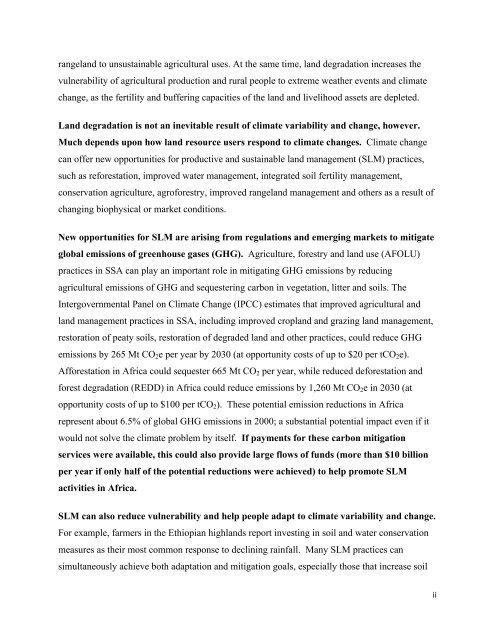The Role of Sustainable Land Management for Climate ... - CAADP
The Role of Sustainable Land Management for Climate ... - CAADP
The Role of Sustainable Land Management for Climate ... - CAADP
Create successful ePaper yourself
Turn your PDF publications into a flip-book with our unique Google optimized e-Paper software.
!<br />
rangeland to unsustainable agricultural uses. At the same time, land degradation increases the<br />
vulnerability <strong>of</strong> agricultural production and rural people to extreme weather events and climate<br />
change, as the fertility and buffering capacities <strong>of</strong> the land and livelihood assets are depleted.<br />
<strong>Land</strong> degradation is not an inevitable result <strong>of</strong> climate variability and change, however.<br />
Much depends upon how land resource users respond to climate changes. <strong>Climate</strong> change<br />
can <strong>of</strong>fer new opportunities <strong>for</strong> productive and sustainable land management (SLM) practices,<br />
such as re<strong>for</strong>estation, improved water management, integrated soil fertility management,<br />
conservation agriculture, agr<strong>of</strong>orestry, improved rangeland management and others as a result <strong>of</strong><br />
changing biophysical or market conditions.<br />
New opportunities <strong>for</strong> SLM are arising from regulations and emerging markets to mitigate<br />
global emissions <strong>of</strong> greenhouse gases (GHG). Agriculture, <strong>for</strong>estry and land use (AFOLU)<br />
practices in SSA can play an important role in mitigating GHG emissions by reducing<br />
agricultural emissions <strong>of</strong> GHG and sequestering carbon in vegetation, litter and soils. <strong>The</strong><br />
Intergovernmental Panel on <strong>Climate</strong> Change (IPCC) estimates that improved agricultural and<br />
land management practices in SSA, including improved cropland and grazing land management,<br />
restoration <strong>of</strong> peaty soils, restoration <strong>of</strong> degraded land and other practices, could reduce GHG<br />
emissions by 265 Mt CO 2 e per year by 2030 (at opportunity costs <strong>of</strong> up to $20 per tCO 2 e).<br />
Af<strong>for</strong>estation in Africa could sequester 665 Mt CO 2 per year, while reduced de<strong>for</strong>estation and<br />
<strong>for</strong>est degradation (REDD) in Africa could reduce emissions by 1,260 Mt CO 2 e in 2030 (at<br />
opportunity costs <strong>of</strong> up to $100 per tCO 2 ). <strong>The</strong>se potential emission reductions in Africa<br />
represent about 6.5% <strong>of</strong> global GHG emissions in 2000; a substantial potential impact even if it<br />
would not solve the climate problem by itself. If payments <strong>for</strong> these carbon mitigation<br />
services were available, this could also provide large flows <strong>of</strong> funds (more than $10 billion<br />
per year if only half <strong>of</strong> the potential reductions were achieved) to help promote SLM<br />
activities in Africa.<br />
SLM can also reduce vulnerability and help people adapt to climate variability and change.<br />
For example, farmers in the Ethiopian highlands report investing in soil and water conservation<br />
measures as their most common response to declining rainfall. Many SLM practices can<br />
simultaneously achieve both adaptation and mitigation goals, especially those that increase soil<br />
!<br />
""!

















